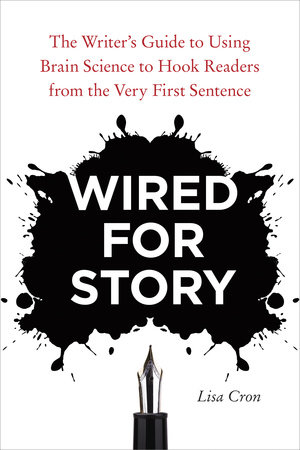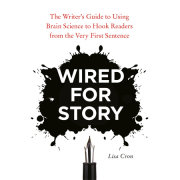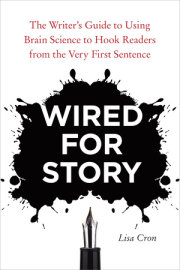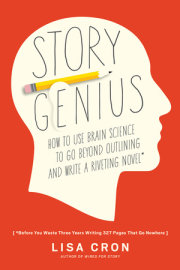I find that most people know what a story is until they sit down to write one.
—Flannery O’Connor
In the second it takes you to read this sentence, your senses are showering you with over 11,000,000 pieces of information. Your conscious mind is capable of registering about forty of them. And when it comes to actually paying attention? On a good day, you can process seven bits of data at a time. On a bad day, five.(1) On one of those days? More like minus three.
And yet, you’re not only making your way in a complex world just fine, you’re preparing to write a story about someone navigating a world of your creation. So how important can any of those other 10,999,960 bits of information really be?
Very, as it turns out—which is why, although we don’t register them consciously, our brain is busy noting, analyzing, and deciding whether they’re something irrelevant (like the fact that the sky is still blue) or something we need to pay attention to (like the sound of a horn blaring as we meander across the street, lost in thought about the hunky guy who just moved in next door).
What’s your brain’s criterion for either leaving you in peace to daydream or demanding your immediate and total attention? It’s simple. Your brain, along with every other living organism down to the humble amoeba, has one main goal: survival. Your subconscious brain—which neuroscientists refer to as the adaptive or cognitive unconscious—is a finely tuned instrument, instantly aware of what matters, what doesn’t, why, and, hopefully, what you should do about it.(2) It knows you don’t have the time to think, “Gee, what’s that loud noise? Oh, it’s a horn honking; it must be coming from that great big SUV that’s barreling straight at me. The driver was probably texting and didn’t notice me until it was too late to stop. Maybe I should get out of the—”
Splat.
And so, to keep us from ending up as road kill, our brain devised a method of sifting through and interpreting all that information much, much faster than our slowpoke conscious mind is capable of. Although for most other animals that sort of innate reflex is where evolution called it a day, thus relegating their reactions to what neuroscientists aptly refer to as zombie systems, we humans got a little something extra.(3) Our brain developed a way to consciously navigate information so that, provided we have the time, we can decide on our own what to do next.
Story.
Here’s how neuroscientist Antonio Damasio sums it up: “The problem of how to make all this wisdom understandable, transmissible, persuasive, enforceable—in a word, of how to make it stick—was faced and a solution found. Storytelling was the solution—storytelling is something brains do, naturally and implicitly. . . . [I]t should be no surprise that it pervades the entire fabric of human societies and cultures.”(4)
We think in story. It’s hardwired in our brain. It’s how we make strategic sense of the otherwise overwhelming world around us. Simply put, the brain constantly seeks meaning from all the input thrown at it, yanks out what’s important for our survival on a need-to-know basis, and tells us a story about it, based on what it knows of our past experience with it, how we feel about it, and how it might affect us. Rather than recording everything on a first come, first served basis, our brain casts us as “the protagonist” and then edits our experience with cinema-like precision, creating logical interrelations, mapping connections between memories, ideas, and events for future reference.(5)
Story is the language of experience, whether it’s ours, someone else’s, or that of fictional characters. Other people’s stories are as important as the stories we tell ourselves. Because if all we ever had to go on was our own experience, we wouldn’t make it out of onesies.
Now for the really important question—what does all this mean for us writers? It means that we can now decode what the brain (aka the reader) is really looking for in every story, beginning with the two key concepts that underlie all the cognitive secrets in this book:
1. Neuroscientists believe the reason our already overloaded brain devotes so much precious time and space to allowing us to get lost in a story is that without stories, we’d be toast. Stories allow us to simulate intense experiences without actually having to live through them. This was a matter of life and death back in the Stone Age, when if you waited for experience to teach you that the rustling in the bushes was actually a lion looking for lunch, you’d end up the main course. It’s even more crucial now, because once we mastered the physical world, our brain evolved to tackle something far trickier: the social realm. Story evolved as a way to explore our own mind and the minds of others, as a sort of dress rehearsal for the future.(6) As a result, story helps us survive not only in the life-and-death physical sense but also in a life-well-lived social sense. Renowned cognitive scientist and Harvard professor Steven Pinker explains our need for story this way:
Fictional narratives supply us with a mental catalogue of the fatal conundrums we might face someday and the outcomes of strategies we could deploy in them. What are the options if I were to suspect that my uncle killed my father, took his position, and married my mother? If my hapless older brother got no respect in the family, are there circumstances that might lead him to betray me? What’s the worst that could happen if I were seduced by a client while my wife and daughter were away for the weekend? What’s the worst that could happen if I had an affair to spice up my boring life as the wife of a country doctor? How can I avoid a suicidal confrontation with raiders who want my land today without looking like a coward and thereby ceding it to them tomorrow? The answers are to be found in any bookstore or any video store. The cliché that life imitates art is true because the function of some kinds of art is for life to imitate it.(7)
2. Not only do we crave story, but we have very specific hardwired expectations for every story we read, even though—and here’s the kicker—chances are next to nil that the average reader could tell you what those expectations are. If pressed, she’d be far more likely to refer to the magic of story, that certain je ne sais quoi that can’t be quantified. And who could blame her? The real answer is rather counterintuitive: our expectations have everything to do with the story’s ability to provide information on how we might safely navigate this earthly plane. To that end, we run them through our own very sophisticated subconscious sense of what a story is supposed to do: plunk someone with a clear goal into an increasingly difficult situation they then have to navigate. When a story meets our brain’s criteria, we relax and slip into the protagonist’s skin, eager to experience what his or her struggle feels like, without having to leave the comfort of home.
All this is incredibly useful for writers because it neatly defines what a story is—and what it’s not. In this chapter, that’s exactly what we’ll examine: the four elements that make up what a story is; what we, as readers, are wired to expect when we dive into the first page of a book and try it on for size; and why even the most lyrical, beautiful writing by itself is as inviting as a big bowl of wax fruit.
Copyright © 2012 by Lisa Cron. All rights reserved. No part of this excerpt may be reproduced or reprinted without permission in writing from the publisher.











